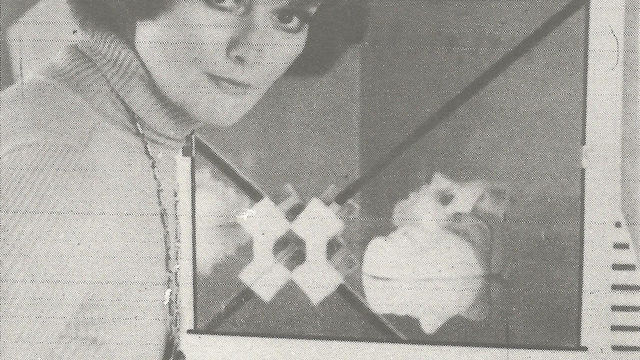
Gloria Gómez-Sánchez
Gloria Gómez-Sánchez was born Gloria Benvenuto Reffray in 1921 in Lima. Initially self-taught, in the mid-1950s she took classes in the private studios of the artists Germán Suárez-Vértiz (1897–1975), Ricardo Grau (1907–1970), and Cristina Gálvez (b. 1919). Between March and September 1958 she lived in Buenos Aires and exchanged studio visits with such leading exponents of Argentine informalism as Alberto Greco (1915–1965). Her active professional artistic career spans only a decade, between 1960 and 1970. During that time she had five solo exhibitions in Lima, participated in fifteen group exhibitions in Peru and abroad, and systematically tested the limits of the newest experimental artistic trends.
Gómez-Sánchez made her Lima debut in 1960 with a painting exhibition at the Instituto de Arte Contemporáneo, which featured a series of intense physical experiments with materials and surface manipulation and the deployment of chance. These works constituted a dramatically distinct approach to abstraction, in contrast to the lyrical telluric model established and championed in Peru by Fernando de Szyszlo (b. 1925). Her second solo exhibition, at Galería Solisol in 1965, brought together precarious assemblages made with flattened everyday objects, refuse, and metal wire. In 1966 she cofounded the group Arte Nuevo together with the artists Luis Arias Vera (1932–2016), Teresa Burga (b. 1935), Jaime Dávila (b. 1937), Víctor Delfín (b. 1927), Emilio Hernández Saavedra (b. 1940), José Tang (b. 1941), Armando Varela (b. 1933), and Luis Zevallos Hetzel (b. 1933). Mentored and promoted by the critic Juan Acha, the group insisted on the renewal of artistic language, bringing together idioms appropriated from pop art, op art, and happenings.
Around 1967 Gómez-Sánchez turned to flattened surfaces, a graphic approach to color and pattern often limited to the primary colors—red, yellow, blue—and figurative female subjects with faces collaged from glossy magazines. These characteristics evocative of pop art amounted to distorted and sexually provocative renderings of women. In November 1970 Gómez-Sánchez presented her last solo exhibition, at Galería Cultura y Libertad in Lima, which signaled her engagement with conceptualism and participatory art and—ultimately—the rejection of professional art circuits. The entire exhibition consisted exclusively of a sign with the phrase "El espacio de esta exposición es el de tu mente. Haz de tu vida la obra" (This exhibition's space is in your mind. Turn your life into an artwork) and a table with the manifesto "¿Se acabó el arte?" (Is art over?). Few works by Gómez-Sánchez have survived. The artist destroyed many of her objects and assemblages during the 1970s. She died in 2007 in Lima.
—Dorota Bizcel
Selected Solo and Group Exhibitions
1965 Gloria Gómez-Sánchez: Yllomomo, Galería Solisol, Lima
1966 Contemporary Peruvian Paintings and Sculptures, Corcoran Gallery of Art, Washington, DC
1967 Arte Nuevo, Galería Lirolay, Buenos Aires
1968 Gloria Gómez-Sánchez: Rojo, amarillo y azul; Cuadros y objetos, Fundación para las Artes, Lima
2014 Gloria Gómez-Sánchez: Una década de mutaciones (1960–1970), Instituto Cultural Peruano Norteamericano, Lima
Selected Bibliography
Carvallo de Núñez, Carlota. "Notas de arte: Nueve preguntas a Gloria Gómez-Sánchez." Alpha 4 (January–March 1968): 41–42.
de la Presa, Fernando. "Artes plásticas: La primera informalista peruana." La Prensa (Lima), March 6, 1960.
López, Miguel A., and Emilio Tarazona. "Juan Acha y la revolución cultural: La transformación de la vanguardia artística en el Perú a fines de los sesenta." In Temas de arte peruano 3: Nuevas referencias sociológicas de las artes visuales; Mass media, lenguajes, represiones y grupos, Juan Acha, 1969, 1–17. Lima: Universidad Ricardo Palma, 2008.
Tarazona, Emilio. "Gloria Gómez-Sánchez: Semblanza de una artista-hito para la vanguardia peruana." Illapa 4 (December 2007): 11–14.


